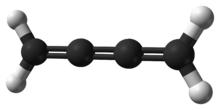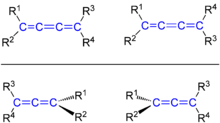Cumulene

A cumulene is a hydrocarbon with three or more cumulative (consecutive) double bonds.[1] They are analogous to allenes, only having a more extensive chain. The simplest molecule in this class is butatriene (H2C=C=C=CH2), which is also called simply cumulene. Unlike most alkanes and alkenes, cumulenes tend to be rigid, comparable to alkynes, which makes them appealing for molecular nanotechnology. Polyynes are another kind of rigid carbon chains. Cumulenes are found in regions of space where hydrogen is rare (see astrochemistry). Cumulenes containing heteroatoms are called heterocumulenes;[2] an example is carbon suboxide.
Synthesis
The first reported synthesis of a butatriene is that of tetraphenylbutatriene in 1921.[3] The most common synthetic method for butatriene synthesis is based on reductive coupling of a geminal dihalovinylidene.[4] Tetraphenylbutatriene was reported synthesized in 1977 by homocoupling of 2,2-diphenyl-1,1,1-tribromoethane with elemental copper in dimethylformamide.[5]
Structure

The rigidity of cumulenes arises from the fact that the internal carbon atoms carry two double bonds. Their sp hybridisation results in two π bonds, one to each neighbor, which are perpendicular to each other. This bonding reinforces a linear geometry of the carbon chain. If the number of consecutive double bonds is odd, there is cis–trans isomerism as for alkenes. Cumulenes with non-equivalent substituents on each end exhibit isomerism. If the number of consecutive double bonds is even, there is axial chirality as for allenes.
Reactivity
The reactions of cumulene are those of simple isolated double bonds because the consecutive double bonds are not conjugated to each other.
Transition metal cumulenes
The first reported complex containing a vinylidene ligand was (Ph2C2Fe2(CO)8, derived from the reaction of diphenylketene and Fe(CO)5 Structurally, this molecule resembles Fe2(CO)9, wherein one μ-CO ligand is replaced by 1,1-diphenylvinylidene, Ph2C2. The first monometallic vinylidene complex was (C5H5)Mo(P(C6H5)3)(CO)2[C=C(CN)2]Cl.[6]
See also
- Allene
- Cyclopropatriene and cyclohexahexaene, cyclic cumulenes
References
- ↑ IUPAC, Compendium of Chemical Terminology, 2nd ed. (the "Gold Book") (1997). Online corrected version: (2006–) "cumulenes".
- ↑ IUPAC, Compendium of Chemical Terminology, 2nd ed. (the "Gold Book") (1997). Online corrected version: (2006–) "heterocumulenes".
- ↑ Brand, K. (17 September 1921). "Über Untersuchungen in der Tetraarylbutan-Reihe und über das 1.1 4.4-Tetraphenyl-butatrien. (4. Mitteilung über die Reduktion organischer Halogen-verbindungen.)". Berichte der deutschen chemischen Gesellschaft (A and B Series). 54 (8): 1987–2006. doi:10.1002/cber.19210540828.
- ↑ Leroyer, Léo; Maraval, Valérie; Chauvin, Remi (2012). "Synthesis of the Butatriene C4 Function: Methodology and Applications". Chemical Reviews. 112 (3): 1310–1343. ISSN 0009-2665. doi:10.1021/cr200239h.
- ↑ Kunieda, Takehisa; Takizawa, Takeo (1977). "Convenient preparation of tetraarylbutatrienes". Chemical & Pharmaceutical Bulletin. 25 (7): 1809–1810. doi:10.1248/cpb.25.1809.
- ↑ King, R. Bruce (August 2004). "The beginnings of terminal vinylidene metal complex chemistry through the dicyanomethylene/oxygen analogy: dicyanovinylidene transition metal complexes". Coordination Chemistry Reviews. 248 (15–16): 1533–1541. doi:10.1016/j.ccr.2004.05.003.